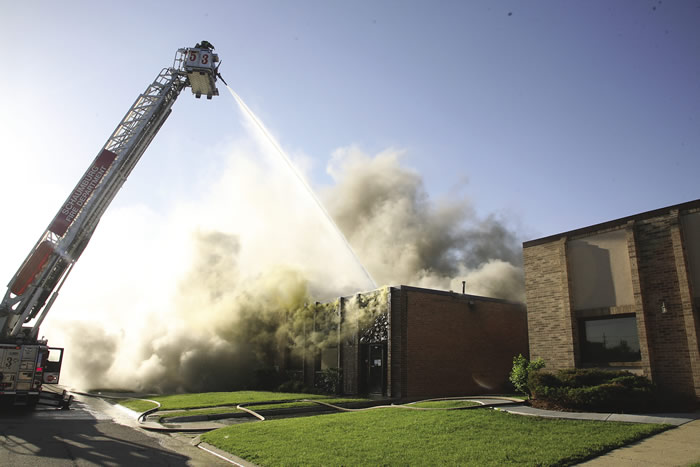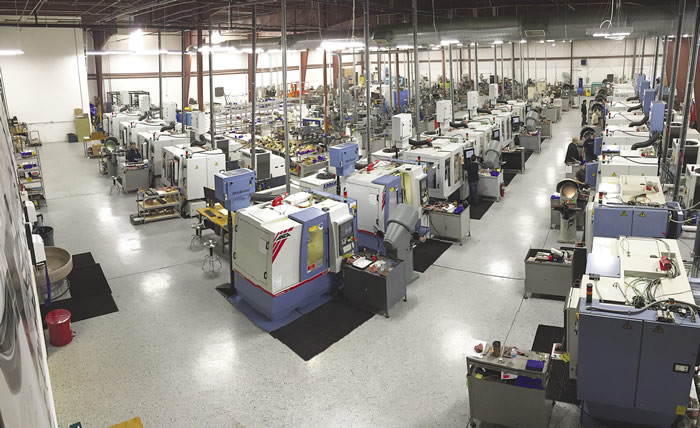Virtually every established manufacturer has experienced at least one major setback during its history. For Taurus Tool & Engineering, it was losing its main tool grinding area and CNC machines to a fire in June 2014, after a 37-year run at its previous facility in Schaumburg, Ill. No injuries were reported, thankfully, and the cause of the fire is unknown.
Within about a month of the fire, the toolmaker received the keys to a larger, 25,000-sq.-ft. facility in Batavia, Ill., and began filling it with 16 5-axis CNC grinders, said Richard Thiele, who purchased the company in whole in February 2015, along with Jim Kantak and Roger Wise.


Above: Firefighters work to extinguish a fire at Taurus Tool’s previous facility in Schaumburg, Ill. Below: The production area at the plant in Batavia, Ill., where the company relocated. Image courtesy Taurus Tool & Engineering.


“We support the grinders with six fully functional, solid-model simulators,” Thiele said. “The entire facility is climate-controlled, and the grinding department is supported by a 240,000-Btu, closed-loop chiller.”
In addition, Taurus restructured its other nine departments, including a four-machine CNC milling department and a 12-machine manual department.
“We have a gorgeous facility, amazing staff and top-notch equipment,” Thiele said.
Taurus Tool produces a range of cutting tools, including drills, endmills, reamers and counterbores, in HSS, carbide, carbide-tipped and diamond-tipped varieties.
Related Glossary Terms
- computer numerical control ( CNC)
computer numerical control ( CNC)
Microprocessor-based controller dedicated to a machine tool that permits the creation or modification of parts. Programmed numerical control activates the machine’s servos and spindle drives and controls the various machining operations. See DNC, direct numerical control; NC, numerical control.
- gang cutting ( milling)
gang cutting ( milling)
Machining with several cutters mounted on a single arbor, generally for simultaneous cutting.
- grinding
grinding
Machining operation in which material is removed from the workpiece by a powered abrasive wheel, stone, belt, paste, sheet, compound, slurry, etc. Takes various forms: surface grinding (creates flat and/or squared surfaces); cylindrical grinding (for external cylindrical and tapered shapes, fillets, undercuts, etc.); centerless grinding; chamfering; thread and form grinding; tool and cutter grinding; offhand grinding; lapping and polishing (grinding with extremely fine grits to create ultrasmooth surfaces); honing; and disc grinding.
- high-speed steels ( HSS)
high-speed steels ( HSS)
Available in two major types: tungsten high-speed steels (designated by letter T having tungsten as the principal alloying element) and molybdenum high-speed steels (designated by letter M having molybdenum as the principal alloying element). The type T high-speed steels containing cobalt have higher wear resistance and greater red (hot) hardness, withstanding cutting temperature up to 1,100º F (590º C). The type T steels are used to fabricate metalcutting tools (milling cutters, drills, reamers and taps), woodworking tools, various types of punches and dies, ball and roller bearings. The type M steels are used for cutting tools and various types of dies.
- milling
milling
Machining operation in which metal or other material is removed by applying power to a rotating cutter. In vertical milling, the cutting tool is mounted vertically on the spindle. In horizontal milling, the cutting tool is mounted horizontally, either directly on the spindle or on an arbor. Horizontal milling is further broken down into conventional milling, where the cutter rotates opposite the direction of feed, or “up” into the workpiece; and climb milling, where the cutter rotates in the direction of feed, or “down” into the workpiece. Milling operations include plane or surface milling, endmilling, facemilling, angle milling, form milling and profiling.

